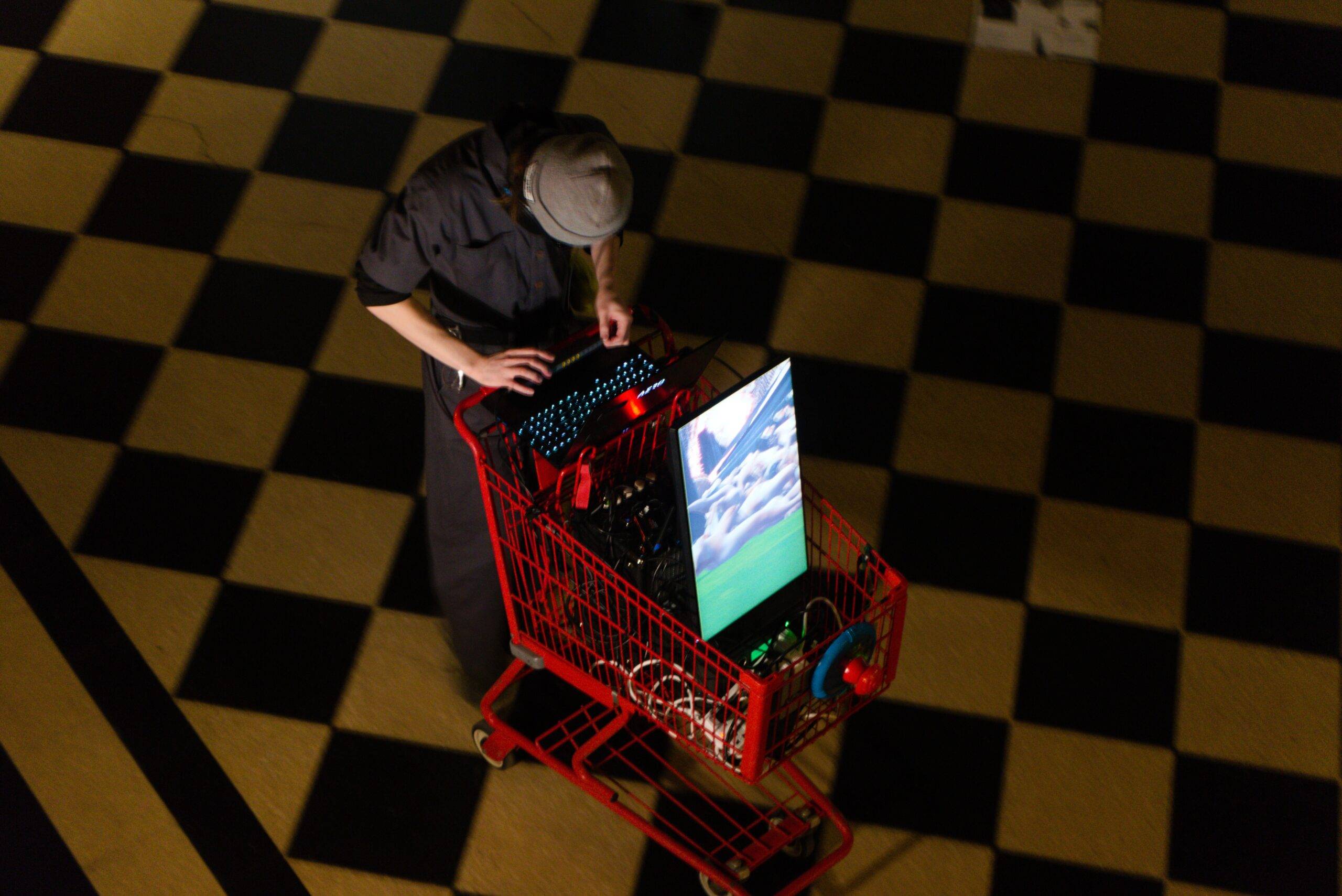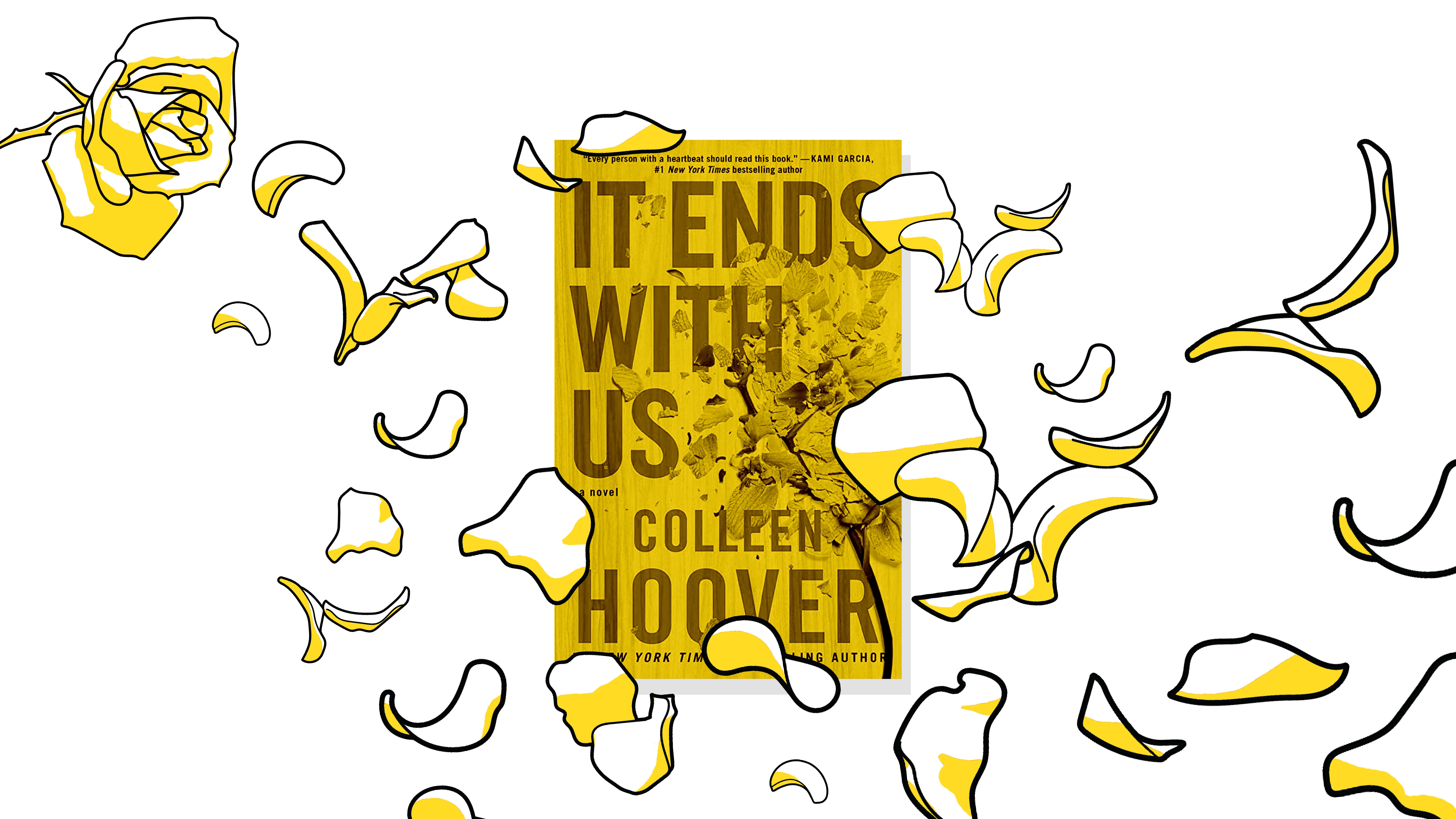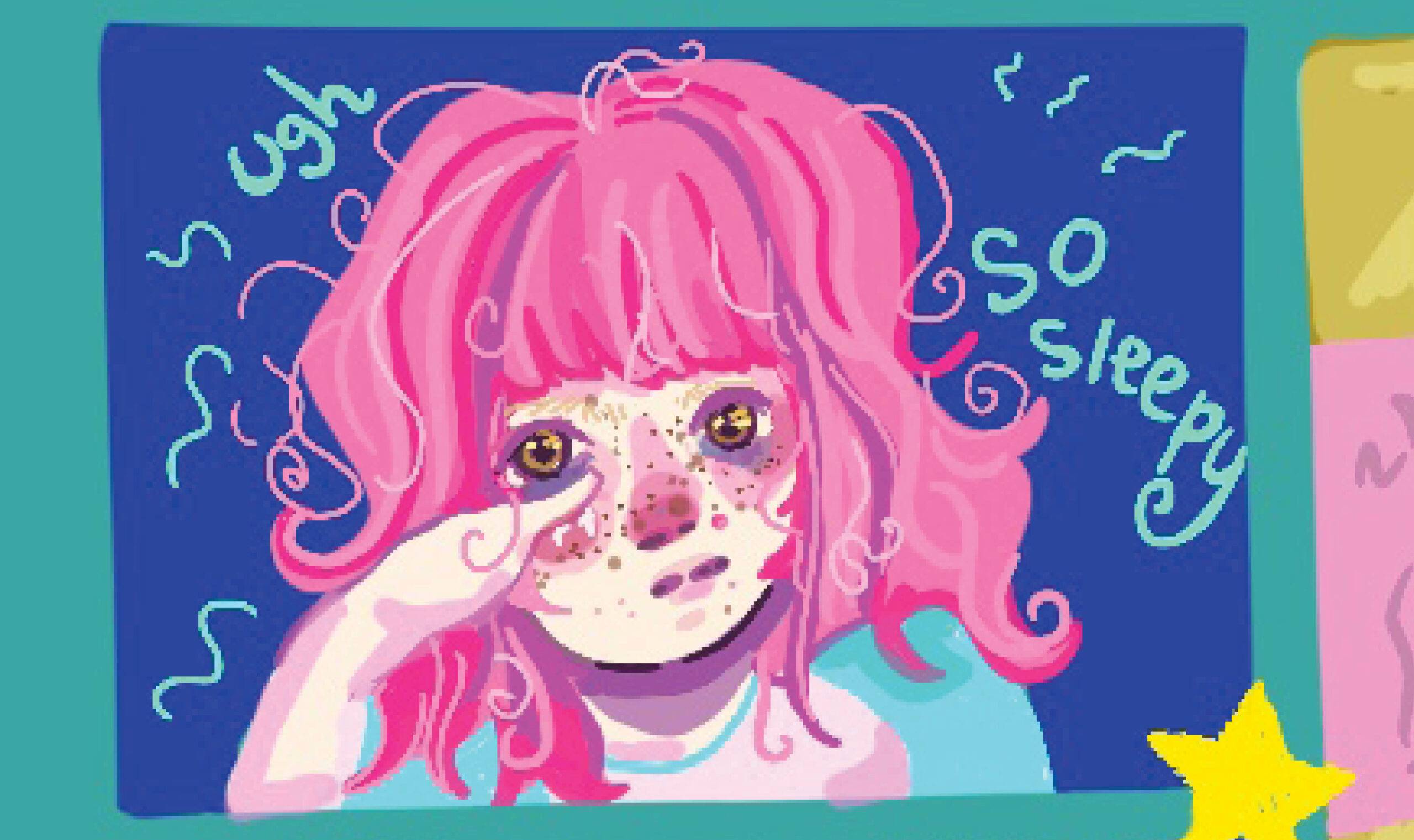
//sense, a collective that explores new media, technologies, video, sound, performance, installation, and beyond, presented an experimental theater performance in School of the Art Institute of Chicago (SAIC) ’s MacLean Ballroom on March 26th, This show featured over 40 artists across multiple disciplines. The two spacious floors of the ballroom alongside a balcony allowed performers to explore a huge space as well as enabled the audience to experience simultaneous performances.
The performance started ambiguously with different performers doing announcements and holding spontaneous conversations and dialogues with microphones. The wireless microphones were then randomly passed among audiences. With a sense of immersion, different modules of performances started one after another on both floors in the Ballroom. After performers finished their first collaboration, some shifted to their second work while others jammed with each other and totally improvised. Audiences were welcome to body jamming, making sound, interacting, intervening, and beyond.
With audiences and performers moving freely in the space, spatial relations became fluid. Audiences could choose their ways to participate, either watching several performances simultaneously, or watching one by one following their chosen path. With a mixture of sounds from all performances, the ballroom became a collective theatrical space.
With questions about artists’ experience of experimental theater, and their upcoming rerun at No Nation Art Lab on April 16th, Jiarui Li interviewed participants of the performance: Yiyi Liu (MFA Art and Technology Studies 24), Yezhou Zheng (MFA Film, Video, New Media, and Animation 24), Kyriakos Apostolidis (MFA Performance 24), and Caroline Preziosi (MFA Writing 23) about their performances.
Interview with Yiyi Liu
Embracing interactivity and absurdity, Liu performed with a red shopping cart that moved around the floor tile in the ballroom. He put a display monitor in the cart showing his interactive video piece “overload.love” (2023). By activating a wired button on the cart front, an old man character would react with an animated heartbeat. Further iterations trigger more replicated men to fall from the sky. As more characters crowded the program, the game could get overloaded and eventually create glitches. Both the visual and the sound of characters falling off are synchronized with rhythms. As Liu pushed the cart around, he interacted with audiences and performers.
Q: Why do you use game engines to create art? Are there any specific video games that inspired your works?
A: I enjoy real-time features in the game engine. all visual contents are unique and driven by operation. In my practice with game engines, the character movement is computationally generated by simulating physical rules in reality, and the game engine makes it easy to achieve this.
I took inspiration from video games like “Grand Theft Auto 5” (GTA 5). One particular scene that caught my attention was when Trevor Philips(one of the main characters in the video game ) was bumped out like a ragdoll by a truck, and hit the ground. I fell in love with the realistic physical simulation in the game. The quirky and graceful poses of characters, called “ragdoll mode,” in “Human Fall Flat” also fascinated me.
The biggest creative inspiration was “KIDS,” a work by Swiss artist Michael Frei. In one scene, you control a small person running through a crowd but forever being avoided by those around you, leaving you alone in the center of an empty circle. This feeling of isolation was magnified by the simple interactive format, and it was this aspect that resonated most with me.
Q: What motivates you to make your works into video works instead of making them as actual games?
A: Video is a great format for presenting games as it allows the recording of real-time gameplay footage, presenting it in a documentary-like form. My practice, however, utilizes video games as a foundation for exploring interactions. I have been experimenting with a heartbeat sensor to control a character’s movements and attaching buttons to a shopping cart to interact with audiences. These explorations represent new forms of interaction that extend beyond the limitations of video game media.
Q: Repetition and rhythm are a big part of both visual and audio in your works. Do you usually let the audio lead the visual or do you usually let the visual lead the audio?
A: I enjoy using the accelerating pattern to arrange my compositions, creating a progression from order to chaos. In my piece “In the Park (2022),” which features a fitness competition among elderly park-goers, the movement progresses from a natural setting to a stage, from order to chaos.
Game engines enable the blurring of boundaries between sound and visual effects through interactive programming. Different conditions within the game can trigger specific sounds, linking them to the logic of the game space. In “overload.love,” I linked the pitch of the background music to the computer’s real-time frame rate. As the frame rate drops, the sound becomes distorted. I also created a rhythm with the sound of the heartbeat, anticipating that the audience would be pressing the “heartbeat button” frantically (which is exactly what happened), causing the sound effects to become the main beat.
Q: In collaboration with other //sense artists, what ideas have you retained/changed compared to your solo works? Are there any inspiration through the experimental theater that you would want to explore in the future?
A: I make the interaction go beyond the interface and become a movement. My latest performance-installation “crash studio” (2023) contains my game program “overload.love” (2023). I put a display monitor in a shopping cart and placed a trigger button in the front. I pushed the cart around and bumped into people during the live show to activate the button. It was funny to see that people actually preferred to frantically tap the button instead of waiting for the collision. This gave me more ideas to explore.
For the next iteration, I plan to add more buttons and involve other performers in the act, so that we can go beyond the boundaries of my imagination. This is the beauty of collaboration!
Interview with Kyriakos Apostolidis
Extending the concept of body movements, Apostolidiss engaged as an improviser in the ballroom. He interacted with different video works and body jammed with other performers. The collaboration between Apostolidis’s body movement and Liu’s game added more humorous to “overload.love.” Apostolidis was using his crotch hitting the button on the cart. With a rhymed hitting, the sound of hitting and the sound from “overload.love” created new beats for the piece. During the performance, Apostolidisinteracted with different video works and body jammed with other performers. The interests of using pure body composed the majority part both in his collaboration and solo works.
Q: Your works contain a sense of wildness, and your performance seems like a mimicry of some non-human creatures to me. How did you find your way of performance? What inspired you?
A: I pursue a raw expression of the human body. The rawness in my work creates a primitive aesthetic, which is associated with wildness through the mimicry of animals or even creatures. This way of working is a result of extended research on different performing practices that focus on psycho-physical awareness. My inspiration is driven by the unknown, innate nature of human existence, which is impossible to draw from in our daily life because of the commands of civilization. Through my performances, I want to connect and make visible this overlapped, primordial body that I believe is a more essential relationship with myself.
Q: Your performances focus on solo practice, what is the biggest difference for you between solo and collaboration?
A: The difference between solo work and collaboration is very slight but very significant for me. The way I approach performance space has a conceptual meaning for my work. The core idea centers around respect for space. When I perform solo, I perceive the presence of my body in equal relation to the presence of the surrounding space. This coexistence makes me perceive the space as a partner who supports the development of my physical action. This partnership begins with my attitude toward performing in the space and how the space itself gives me feedback on the understanding of my presence. I share my presence with other performers in the space. When I perform collaboratively, I feel the responsibility to become a supporter of collective action’s unity as it creates and develops a common atmosphere. The perception of space gets a layer deeper as I activate an instinctive awareness of taking instant decisions that can inspire my collaborators.
Interview with Yezhou Zheng
By giving bodily responses to video works in front of the big projector on the stage in the first floor Ballroom, Apostolidis froze with the gesture of both arms stretching out. Marshall McLuhan in the book “Understanding Media” proposed the idea that media that are filled with information are “hot media,” whereas media that leave space for people to fill information in are “cool media.” Mcluhan gives the example that films and videos are types of hot media as the information is already defined by the makers. However, with Apostolidis’s body involvement, more information is added to a hot media. The collaboration “Rehearsal” also built upon this idea that Zheng projected his video works and used a camera to “interrupt the chain of responding” between the video the performer, who gave responses to the video, and a text generator who gave responses to the performer. The idea of interruption and information conversion are frequently used in //sense’s notion of being experimental.
Q: You are using different visuals in different pieces including 3D animations, 2D animations, and real-life videos. How do you usually choose visuals when creating the works?
A: My previous works focused strongly on narrative, and I felt that branching out and exploring moving images through a different medium would be a helpful way to challenge myself as an artist. When it comes to visual styles, I don’t start with a preconceived idea of how the visuals should look like. Instead, I let the visuals emerge naturally as I work on the project. I believe that visuals have their own inherent principles and roots, and I make works that are in harmony with those principles.
Q: Language plays an important role in your video narrative works, did you use language within the context of an experimental theater?
A: For the experimental theater, I’m making silent videos for two different groups, as I wanted to experiment with silence as an element. The lack of sound creates a unique atmosphere that is open to interpretation and allows the visuals to stand on their own. In terms of collaboration, the absence of sound in my videos allows performers to explore and engage with, leaving space for their own interpretations and interactions with the visuals.
Q: I see your animation work-in-progress (2020) as an abstract work that departs from your previous works. What sparks the change in style?
A: I was studying animation and my goal was to explore motion and duration in a more experimental context. My previous works had a stronger narrative focus, so I attempted to explore other forms of moving image.
Q: In collaboration with other //sense artists, what ideas have you retained/changed compared to your solo works? Are there any inspiration through the experimental theater that you would want to explore in the future?
A: Working with different artists has been a fantastic experience. It’s been inspiring to see the possibilities that collaboration between moving-image and performance can offer. I’m excited to see where my collaborations take me in the future.
After the first round of collaboration, we gained new ideas of how //sense approached the concept of experimental theater, which was largely inspired by historical models like Gutai and Fluxus. The performance gave both the audiences and the performers a nonlinear structure. By using a large space and by having a variety of artists’ art practices, //sense composed an openness and randomness of an experimental theater. With new line-up and modified modules, //sense artists will collaborate with each other in new ways in the upcoming rerun titled “&& transmission loss through mcluhanian feedback loops across the foucauldian heterotopic border of nonation.” It will take place at 7pm on April 16th at No Nation Art Lab with a live stream starting at 7:00pm on the Experimental Sound Studio Channel. By performing at No Nation Art Lab, artists will create new modules within a smaller space. This site-changing and the adjustment to the works brings more indeterminacy to the experimental structure.







